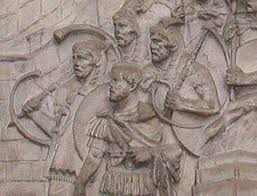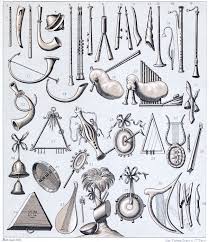While Ancient Roman music was influenced by numerous places, Etruscan and Greek music played a major role. The Empire was also influenced by North Africa, Gaul, and Asia Minor.

Music was a major part of numerous events like entertainment possessions such as gladiator marches, public ceremonies, military processions, and religious events like weddings, sacrifices and funerals. Romans showed great appreciation for music.
Asides from entertainment, music served religious purposes in ancient Rome as it was an important part of worshipping their gods.
These days, there are numerous frescoes, mosaics, and wall paintings showing people and mythological figures playing musical instruments that have been discovered.
This serves as further proof of the importance of music in ancient Roman society. However, while there are pictures, there is no oral documentation of the songs. Hence, all we have to glimpse into their life remains the numerous drawings, writings and instruments discovered.
It is unfortunate that there was no way to preserve oral music then and this makes it easy to overlook how important music was to the Ancient Romans. Music literally meaning ‘of the Muses’, was perceived as something inspired by the gods and hence was performed in worship to the Roman gods too.
It’s easy to assume music from ancient Rome as basic performed with a fixed number of musical instruments. However, this is far from the truth. Not much is left of ancient Roman music, but Roman citizens had numerous musical instruments and their music was far from basic.
The Romans used quite a number of musical instruments, some still known and used in the present day. Some also served as prototypes of instruments that we use today.
Roman musical instruments
The numerous musical instruments of ancient Rome could have specific ways of playing either solo, in groups, or to accompany dancers or singers. Two of the most popular string instruments from that time were the lyra, made with a tortoise-shell sound box, and the cithara, a much larger lyre-type instrument made of wood with a bigger sound box (this made it popular among professional musicians, who benefited from its louder sound).
Wind instruments: One of the most popular wind instruments was the tuba. It was a long woodwind instrument made from bronze and identical to a trumpet. It had a conical mouthpiece which was separable. It was also used in public events, ceremonies and by the military. The tibia, another popular wind instrument, was like a Greek aulos. It was believed to ward off evil spirits when played at funerals.

String instruments: Romans had beautiful string instruments such as the Lyra, the cithara, the lute or the harp. The Lyra had its origins in Greece. It was made of a tortoise shell or a wooden-sounding body, two arms made of animal horn or wood, and strings attached to a crossbar and stretching to the sounding body. The cithara which also came from Greece replaced the lyra. While the lyra was played sitting down, the cithara was played standing up.
Romans had the sambuca which looks similar to a large harp and the trigonum which resembles a small harp which could be handheld.
Percussion instruments: Romans had bells, tambourines, rattles made of wood or metal or the sacellum used to beat time. They had other percussion instruments like the timpani, the sistrum and the cymbala which were cymbals that clashed together to produce a sound.
Other instruments: Romans had more elaborate musical instruments such as the hydraulis which was a water pipe organ that functioned with water pressure.
What Was Roman Music Like?
The ancient Romans were profoundly influenced in their music by Mediterranean, Greek and Etruscan cultures.
We have learnt about the music of ancient Rome by studying the musical instruments which were discovered. However, some passages of ancient Greek musical notations that have been discovered also contain information on ancient Roman music.
The most famous piece of ancient Roman music is the Seikilos song, found inscribed on a funeral epitaph in Turkey, and dated to around the 1st century CE. It is also the earliest complete piece of music in the world
Music and religion were inseparable in the ancient world. Apollo, one of the foremost gods and patron of music and dance in Roman mythology, had his son, Orpheus, closely associated with the lyre.
Numerous Roman mythologies portray their gods and deities in relation to music and musical instruments. This is why Faunus, the horned god of the forest and the equivalent of the Greek deity Pan, was typically depicted playing the flute or the pan pipes.
Finally, the Romans, no doubt like most other nations throughout history, made war to the sound of drums. Various other instruments and organs and percussion would have been used in the immense ‘triumphs’ which were held in Rome to celebrate the deeds of a victorious, conquering general throughout the Roman Republic.